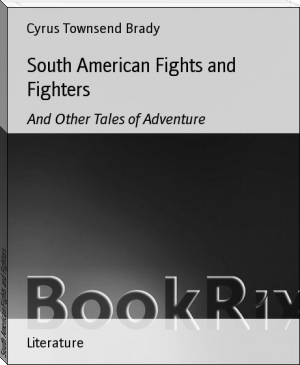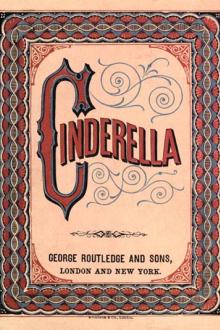South American Fights and Fighters, and Other Tales of Adventure by Brady (rosie project .txt) 📕

Read free book «South American Fights and Fighters, and Other Tales of Adventure by Brady (rosie project .txt) 📕» - read online or download for free at americanlibrarybooks.com
- Author: Brady
Read book online «South American Fights and Fighters, and Other Tales of Adventure by Brady (rosie project .txt) 📕». Author - Brady
Pizarro placed the diadem on Toparca, a youthful brother of the late Inca. When he was alone with his attendants, the boy tore the llauta from his forehead, and trampled it under his foot, as no longer the badge of anything but infamy and shame, and in two short months he pined and died from the consciousness of his disgrace. Whereupon another Peruvian, Manco Capac, the legitimate heir of Huascar, appeared before Pizarro, made good his claim, and on the entry of the conquerors into Cuzco, was crowned Inca with all the ancient ceremonies. He soon realized that he was but a puppet in Pizarro's hands, however, and by and by he, too, made a bold stroke for freedom.
The conquest of Peru was complete. Charles V., dazzled by the report of Hernando Pizarro, and the {93} substantial treasures placed before him, created Pizarro a Marquis of the country, confirmed him in the government of the country for two hundred and seventy leagues south of the Santiago River and gave Almagro authority to conquer everything beyond that limit. Almagro was very much dissatisfied with his share, but concluded, before he made any violent objections, to go to the south and find an El Dorado for himself.
Meanwhile Pizarro, who was almost as much of a builder as Rameses the Great, laid out the city of Lima and the Spaniards flocked into Peru from Spain in thousands. The natives were enslaved and the country divided into great estates, and Almagro and his discontented started for Chili. Hernando Pizarro, who was appointed governor of Cuzco, held young Manco in close confinement, and everything outwardly was as fine and lovely as a summer day. There was growing, however, a tremendous uprising in which hitherto somnolent Fate was about to lay her belated hands upon nearly all the actors of the great drama which had heretofore been so successfully played.
VI. The Inca and the Peruvians Strike Vainly for Freedom
The city of Cuzco was, without doubt, the most superb capital on the American continent. Indeed, in many respects, it would have compared favorably with, let us say, Paris in the sixteenth century, with its narrow, crooked, unpaved filthy streets, its indifferent protections, and its utterly inadequate water and sewer system. The streets, which were broad and level, crossed each other at regular intervals at right angles. They were smoothly paved with large, carefully joined {94} flagstones. The houses in the city were mainly built of stone. The palace of the Inca, which stood alone in the great square, was of marble. The temples and buildings for public assemblages, armories, granaries, storehouses, et cetera, were of great size. The stones used in their erection were of such dimensions that the Spanish marvelled at the engineering genius which could have quarried them and put them in place, just as the people of to-day are amazed at Baalbec and the pyramids. Stone conduits ran down each street, bringing delicious water to each doorway, and the city was traversed by two mountain streams crossed by bridges cut by watergates. That the cold, clear water might be kept pure and sweet, the beds of the rivers like those of the Euphrates at Babylon, had been paved.
The city was surrounded by walls and dominated by a great fortress called Sacsahuaman, which stood upon a steep and rocky hill overlooking the capital. On the side toward the city the fortress was practically impregnable on account of the precipitous slopes of the cliffs. The other side was defended by three stone walls laid out in zigzag shape, with salient and re�ntrant angles (demi-lunes), like an old-fashioned rail fence, with many doors, each closed by stone portcullis, in each wall. Within the walls was a citadel of three tall towers. The whole constituted a most formidable position.
While Francisco Pizarro was founding and laying out on a magnificent scale and with lavish generosity the city of Lima, near the seaboard, Hernando was made governor of Cuzco. Hernando was, without doubt, the most able and most admirable of the Pizarros, although his fame has been obscured by that of his {95} elder brother. He had been directed by Charles V to treat the Inca and the people with kindness, and, perhaps on that account, he had not exercised so rigorous a surveillance over the movements of young Manco as his ordinary prudence would have dictated. At any rate, the bold and youthful emperor found no difficulty in leaving his ancient capital. He repaired immediately to the Valley of Yucay, in the high mountains of the northeastward of Cuzco. There had been brewing a vast conspiracy against the Spaniards for some time, and at the summons of the Inca, thither resorted the great chiefs of the Peruvians with their retainers and dependents, including their women and children.
The partisans of the two Inca half-brothers, who had not been slain, made common cause with each other. All internal differences were forgotten in the presence of the common enemy. They had much to revenge. Their treasures had been taken, their temples polluted, their religion profaned, their monarchs slain, their women outraged and the people forced into a degrading, exhausting slavery. Strange is it to recognize that human slavery was introduced into Peru by the Christians!
It is good to think that the manhood of the Peruvians was awakened at last. Manco, burning with fiery patriotic zeal, summoned his great vassals and subjects to his standard. "Death to the Spaniards!" were the watchwords that resounded with fierce war-cries among the mountains and hills. With ancient ceremonies, drinking from a common cup, they pledged their lives, their fortunes, and their sacred honor to their hereditary chief in defense of their altars and their fires, their native land.
{96}Early in 1536 a vast army swept down through the mountain passes and made toward the ancient capital. The three Pizarros, Hernando, Juan and Gonzalo, put themselves at the head of their horsemen and sallied out to meet them. They killed numbers of Peruvians, but all their valor could not check the resistless force of the patriotic army. The Spaniards were swept back into the city, glad to escape with their lives before such overwhelming numbers; indeed, only a timely attack by a detachment in the rear of the Peruvians saved them from destruction then and there. Cuzco was at once invested. The Indians, with a heroism which cannot be too greatly commended, endeavored to carry the place by assault.[9]
They set fire to the thatched roofs of their own houses, devoting their city to flames, like the Russians at Moscow, to compass the annihilation of the detested invaders. The wind favored them, and a besom of flame swept over the devoted town until over one-half of it was laid in ruins. There were ninety Spanish horse in the city, probably as many foot, and a thousand Indian auxiliaries, but they were soldiers of the highest quality and led by three captains whose like for daring and skill are not often seen.
No one ever questioned the courage or the military ability of the Pizarros and certainly they exhibited both qualities in full measure during the siege. Of all the brothers, it is probable that Hernando was the most daring cavalier as well as the most capable captain, although in personal prowess his younger brothers were not a whit behind him. Indeed, Gonzalo was {97} reckoned as the best lance in the New World. Stifled by the smoke, scorched by the flames, parched with heat, choked with thirst, exhausted with hunger, crazed from loss of sleep, yet battling with the energy of despair against overwhelming numbers of Indians, who, with a reckless disregard for life, hurled themselves upon the sword-points, the Spaniards after several days of the most terrific fighting, were forced into the square, which they held against their enemy by dint of the most heroic and continuous endeavors.
The Peruvians barricaded the streets with the debris of their ruined houses and sharpened stakes, and prepared to press home for a final attack. Although the slaughter among the Indians had been fearful, the odds against the Spaniards did not appear diminished, for it was learned afterward that there were more than one hundred thousand warriors engaged, and, with a host of followers and servants, the total aggregated at least eighty thousand more. And, indeed, the Spaniards mourned the death of many a brave cavalier and stout man-at-arms. In all the fighting the young Inca, in full war-gear of gold and silver, mounted on a captured horse, with a Spanish lance in his hand, had played a hero's dauntless part.
At the commencement of the siege there had been a discussion as to whether they should occupy the great fortress of Sacsahuaman, or not. Juan Pizarro had dissuaded the Spanish from the attempt, for, he said: "Our forces are too weak to hold both places. The city is the most important, and should it happen that we need the fortress we can take it any time." Without opposition the Indian High Priest had occupied it with a large body of men.
It was evident, at last, that the Spaniards would {98} either have to retreat from their town or seize the fortress, which, now that they had been driven from the walls, commanded their position in the square. Most of the cavaliers were for retreat. There is no doubt that the horse could certainly have cut their way through the ranks of the besiegers, and have escaped, together with most of the foot as well.
Hernando was quite as persistent as his indomitable brother Francisco, however, and he talked equally as well to the soldiers. He made them a stirring address which he closed by declaring that he had been sent there to hold the town, and hold it he would if he had to hold it alone; that he would rather die there in the square with the consciousness that he had kept his trust than abandon the place. Juan and Gonzalo seconded his stirring appeal. It was resolved that the fortress should be taken. Hernando proposed to lead the assault in person, but Juan interposed with the remark that he had objected to its seizure in the first instance, and to him rightfully belonged the leadership of the forlorn hope to repair the error. Hernando consented.
Juan and Gonzalo, with their commands and fifty of their best horse, were detailed for the purpose. By Hernando's instructions they cut through the Indians and galloped headlong down the road in the direction of Lima. The Indians were deceived by the seeming dash of the horsemen through the lines and, supposing them to be in retreat, turned their attention to the Spaniards left in the square. The conflict which had been intermitted for a space began again with the utmost fury.
In the midst of it, Juan Pizarro, who had galloped about a league from the town and then made a long {99} detour, suddenly appeared at Sacsahuaman. The Spaniards immediately rushed to the assault. This diversion caused the Indians, who had been literally forcing the Spaniards in the town up against the wall, and in the last ditch, as it were, to give ground. Thereupon the dauntless Hernando charged upon them, drove them out of the square, and succeeded in establishing communications with Juan and Gonzalo on the hill. He directed Juan to hold his position and make no attack, but Juan thought he saw an opportunity to gain the fortress, and at vespers the Spaniards rushed at the walls.
There were Indians not only within but without the walls, and the fighting was soon of the most sanguinary description. Juan Pizarro had been wounded previously in a skirmish and on account of this wound was unable to wear his morion. Hernando had especially cautioned him to be careful on this account; but the impetuous valor of the Pizarros was not to be restrained by considerations of any personal safety, and Juan was in the front rank of the storming party. They had cut their way through to the fort and were battling for entrance when a stone hurled from the tower struck Juan in the head, knocking him senseless. The wound was of such a character that two weeks afterward he died of it in great agony. He was the first to





Comments (0)